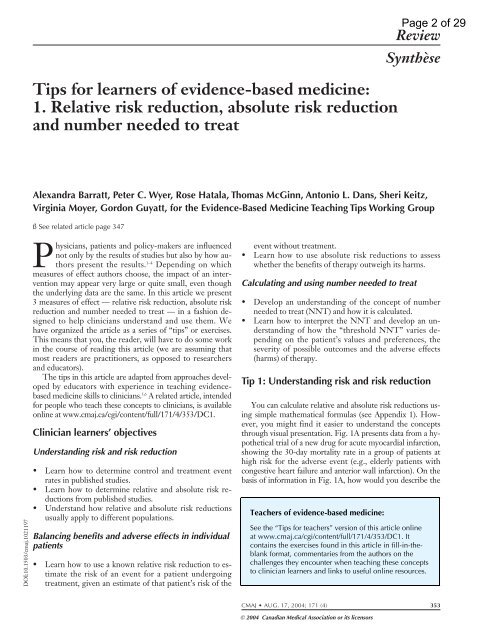Tips for Learners of Evidence-Based Medicine
Tips for Learners of Evidence-Based Medicine
Tips for Learners of Evidence-Based Medicine
Create successful ePaper yourself
Turn your PDF publications into a flip-book with our unique Google optimized e-Paper software.
DOI:10.1503/cmaj.1021197<br />
<strong>Tips</strong> <strong>for</strong> learners <strong>of</strong> evidence-based medicine:<br />
1. Relative risk reduction, absolute risk reduction<br />
and number needed to treat<br />
Physicians, patients and policy-makers are influenced<br />
not only by the results <strong>of</strong> studies but also by how authors<br />
present the results. 1–4 Depending on which<br />
measures <strong>of</strong> effect authors choose, the impact <strong>of</strong> an intervention<br />
may appear very large or quite small, even though<br />
the underlying data are the same. In this article we present<br />
3 measures <strong>of</strong> effect — relative risk reduction, absolute risk<br />
reduction and number needed to treat — in a fashion designed<br />
to help clinicians understand and use them. We<br />
have organized the article as a series <strong>of</strong> “tips” or exercises.<br />
This means that you, the reader, will have to do some work<br />
in the course <strong>of</strong> reading this article (we are assuming that<br />
most readers are practitioners, as opposed to researchers<br />
and educators).<br />
The tips in this article are adapted from approaches developed<br />
by educators with experience in teaching evidencebased<br />
medicine skills to clinicians. 5,6 A related article, intended<br />
<strong>for</strong> people who teach these concepts to clinicians, is available<br />
online at www.cmaj.ca/cgi/content/full/171/4/353/DC1.<br />
Clinician learners’ objectives<br />
Understanding risk and risk reduction<br />
• Learn how to determine control and treatment event<br />
rates in published studies.<br />
• Learn how to determine relative and absolute risk reductions<br />
from published studies.<br />
• Understand how relative and absolute risk reductions<br />
usually apply to different populations.<br />
Balancing benefits and adverse effects in individual<br />
patients<br />
• Learn how to use a known relative risk reduction to estimate<br />
the risk <strong>of</strong> an event <strong>for</strong> a patient undergoing<br />
treatment, given an estimate <strong>of</strong> that patient’s risk <strong>of</strong> the<br />
CMAJ • AUG. 17, 2004; 171 (4) 353<br />
© 2004 Canadian Medical Association or its licensors<br />
Review<br />
Synthèse<br />
Alexandra Barratt, Peter C. Wyer, Rose Hatala, Thomas McGinn, Antonio L. Dans, Sheri Keitz,<br />
Virginia Moyer, Gordon Guyatt, <strong>for</strong> the <strong>Evidence</strong>-<strong>Based</strong> <strong>Medicine</strong> Teaching <strong>Tips</strong> Working Group<br />
ß See related article page 347<br />
event without treatment.<br />
• Learn how to use absolute risk reductions to assess<br />
whether the benefits <strong>of</strong> therapy outweigh its harms.<br />
Calculating and using number needed to treat<br />
• Develop an understanding <strong>of</strong> the concept <strong>of</strong> number<br />
needed to treat (NNT) and how it is calculated.<br />
• Learn how to interpret the NNT and develop an understanding<br />
<strong>of</strong> how the “threshold NNT” varies depending<br />
on the patient’s values and preferences, the<br />
severity <strong>of</strong> possible outcomes and the adverse effects<br />
(harms) <strong>of</strong> therapy.<br />
Tip 1: Understanding risk and risk reduction<br />
You can calculate relative and absolute risk reductions using<br />
simple mathematical <strong>for</strong>mulas (see Appendix 1). However,<br />
you might find it easier to understand the concepts<br />
through visual presentation. Fig. 1A presents data from a hypothetical<br />
trial <strong>of</strong> a new drug <strong>for</strong> acute myocardial infarction,<br />
showing the 30-day mortality rate in a group <strong>of</strong> patients at<br />
high risk <strong>for</strong> the adverse event (e.g., elderly patients with<br />
congestive heart failure and anterior wall infarction). On the<br />
basis <strong>of</strong> in<strong>for</strong>mation in Fig. 1A, how would you describe the<br />
Teachers <strong>of</strong> evidence-based medicine:<br />
See the “<strong>Tips</strong> <strong>for</strong> teachers” version <strong>of</strong> this article online<br />
at www.cmaj.ca/cgi/content/full/171/4/353/DC1. It<br />
contains the exercises found in this article in fill-in-theblank<br />
<strong>for</strong>mat, commentaries from the authors on the<br />
challenges they encounter when teaching these concepts<br />
to clinician learners and links to useful online resources.<br />
Page 2 <strong>of</strong> 29
















